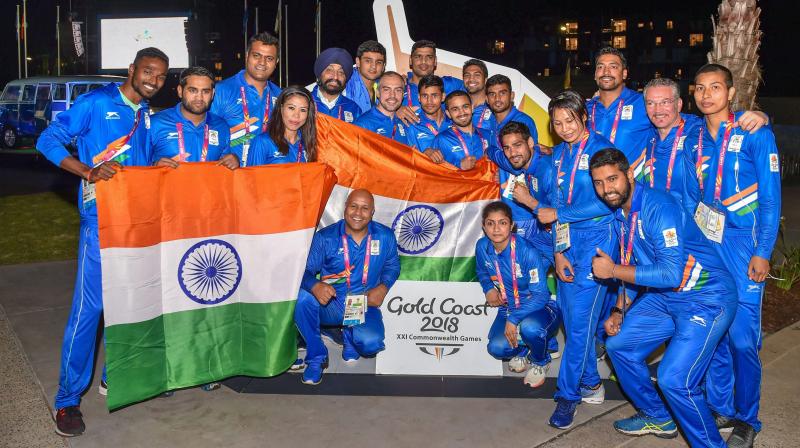CWG 2018: Young and old 'shine bright like a diamond' in India's eventful campaign
With 26 gold, 20 silver and as may bronze medals, India signed off third on the table.

Gold Coast: The exuberance of youth, the endurance of experience and a bit of usual drama that is signature Indian sports -- the country's Commonwealth Games campaign was all this and much more with a medal count that turned out to be the third best ever.
From the teen shooting trio of Manu Bhaker, Mehuli Ghosh and Anish Bhanwala, the historic table tennis performance by Manika Batra to the arrival of a very confident Neeraj Chopra on the big stage, India had its next crop of stars ready to challenge the world.
The redoubtable Saina Nehwal provided the final day golden touch with her women's singles gold, much like the 2010 Games where her top finish was a shade more significant for it took the overall tally to 100.
With 26 gold, 20 silver and as may bronze medals, India signed off third on the table -- a promotion of two positions from Glasgow and it was a combination of youth and experience which delivered the results.
At 2010 Games in New Delhi, India won 101 medal, including 38 gold while at 2002 Manchester Games India had managed a total of 69 medal of which 30 were gold.
The likes of MC Mary Kom, Seema Punia and Sushil Kumar showed that experience can never be discounted either, turning back the clock to deliver performances which were nothing short of awe-inspiring.
While the shooters, weightlifters, wrestlers and the boxers were expected to bring home the maximum share of medal, there was a significant new addition to that in table tennis.
After just one bronze in the 2014 edition, there were significant concerns about how the performance might shape up this time. But Manika Batra was determined to ensure that things turn out differently.
The 22-year-old, who dropped out of college to focus on her game, justified what many would call a massive risk. It was by far the best individual performance by an Indian athlete as she ensnared a historic individual gold, a team gold, a women's doubles silver and a mixed doubles bronze.
On the other end of the spectrum were Mary Kom and Sushil. Without a shadow of doubt among the greatest athletes of their respective sports but faced with questions about their future quite often now, the duo decided to show what it means to turn the clock back.
So, both a 34-year-old Sushil and a 35-year-old Mary Kom gave performances to remember, quite literally schooling their younger opponents just how turn on the style without compromising on the substance.
The sheer diversity of medal winners was a heartwarming aspect of the Games for India. There were medals from squash, although not gold, there were nine medals from boxing, 12 from wrestling, 16 from shooting and nine from weightlifting.
In fact, it was the weightlifters who set the ball rolling with their best ever performance -- the highlight of which was the absence of any doping suspicion. Records tumbled as the likes of Mirabai Chanu, Sanjita Chanu and Sathish Sivalingam remained heads and shoulders above their competitors. Shooters were not to be left behind and almost everyday, a gold tumbled out of the Belmont Shooting Centre in Brisbane.
The only blip was the seasoned Gagan Narang going empty-handed from the event but the mantle was passed on to the likes of Manu, Anish and Mehuli -- the teen trio that lived upto the pre-event hype.
With shooting not a part of the 2022 Birmingham CWG, India would be at a massive loss on the medal count and the performance this time is likely to be cherished for a long time to come. At the badminton courts, it was mostly about Saina and P V Sindhu but K Srikanth continued to create a space of his own, taking down the legendary Lee Chong Wei during the gold-winning team competition.
In the Saina vs Sindhu battle, the former came out trumps, displaying a very special kind of aggression in the final. The boxing arena at the Oxenford Studios was witness to a historic Indian performance in which all eight men in fray won medals -- two gold, three silver and three bronze, while Mary Kom continued to be the top performing woman with her gold. And there was lots to celebrate in track and field too with Neeraj's season's best 86.47m show for gold being the biggest takeaway.
The 20-year-old showed he is one for the future with a performance that had brilliance written all over it. Seema Punia delivered a silver, her second successive, in discus throw, a remarkable achievement for the 34-year-old, whose doping past continues to cast a shadow on her present. But there were disappointments too, the biggest being the two hockey teams.
The women managed to improve to fourth this time from fifth of the past two editions, but the men, silver-medallists in 2010 and 2014 embarrassed themselves with a fourth-place finish. Manpreet Singh's team lacked finesse and resolve, the lowest point of its campaign being a 2-2 draw with a Pakistan in shambles.
The gymnasts, cyclists and swimmers were not really expected to throw up surprises and they didn't either, fading into oblivion without much of a fight. Outisde the competition arena, India battled a couple of embarrassing controversies.
Two athletes -- race walker KT Irfan and triple jumper V Rakesh Babu -- were sent back for failing to explain the presence of needles in their room. Before that, the doctor of the boxing team earned a reprimand for not disposing the needle properly after use, having fulfilled the declaration norms of the no needle policy. Away from the furore, however, India could certainly be glad about emergence of a new crop of athletes ready to conquer the world.

